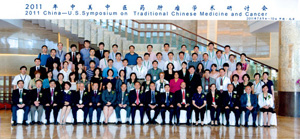Meetings and Events
Spring 2013
Vol. 8, Issue 1
Winter 2013
Vol. 7, Issue 2
Spring 2012
Vol. 7, Issue 1
Spring 2011
Vol. 6, Issue 1
Fall 2011
Vol. 6, Issue 2
Spring 2010
Vol. 5, Issue 1
Fall 2010
Vol. 5, Issue 2
Spring 2009
Vol. 4, Issue 1
Fall 2009
Vol. 4, Issue 2
Spring 2008
Vol. 3, Issue 1
Fall 2008
Vol. 3, Issue 2
Fall 2007
Vol. 2, Issue 2
Winter 2007
Vol. 2, Issue 1
Summer 2006
Vol. 1, Issue 2
Collaboration at top of the agenda at the
China-U.S. Symposium on Traditional
Chinese Medicine and Cancer

on Traditional Chinese Medicine
In July 2011, Dr. Jeffrey D. White, OCCAM Director, and Dr. Libin Jia, who manages many of OCCAM’s international research collaborations, attended the 2011 China-U.S. Symposium on Traditional Chinese Medicine (TCM) and Cancer in Beijing, China. The theme of this meeting was “Confluence and Innovation—Building a Collaborative Bridge between China and the United States on TCM.”
Although this meeting was suggested by Hongsheng Lin, the Director of the Oncology Department at Guang’anmen Hospital, Beijing, China in the fall of 2010, its origins date back to 2006, when OCCAM hosted the conference, “Traditional Chinese Medicine and Cancer Research: Fostering Collaborations; Advancing the Science.” The OCCAM conference brought together researchers from around the world with common interests so they could learn about one another’s work. As a result of this conference, research collaborations were initiated which are still ongoing, including one between the NCI and Guang’ anmen Hospital.
OCCAM worked with the Guang’anmen Hospital staff as well as Dr. Julie Schneider, now with NCI’s Center for Global Cancer Research, and Dr. Elizabeth Yuan, the U.S. Health and Human Services Health Attaché in China, in making the China-United States Symposium a reality. “The meeting was about collaboration between the United States and China on cancer research. We [OCCAM] support several activities which involve such collaborations and we were able to recommend researchers involved in those projects. In addition, we have experience both hosting collaborative projects here in the intramural program at NCI as well as the grant-funded extramural activities,” said Dr. White.
The collaborative spirit of the meeting was evident even in the early stages of planning. “There were several long-distance conference calls and email exchanges,” noted Dr. White. Dr. Jia helped to coordinate with Chinese staff from the Oncology Department at Guang’anmen Hospital. The U.S. Department of Health and Human Services provided funds to support travel for U.S. scientists and the State Administration of TCM of the People’s Republic of China also provided support for several other U.S. and Chinese scientists to come to the meeting.
The presentations during the Symposium focused on international research collaborations between the United States and China, as well as the development of anti-cancer therapies using TCM. Dr. White gave an overview of the NCI CAM research activities and described botanical cancer research in the United States. Dr. Jia detailed United States-China collaborative research projects supported by NCI/OCCAM.
During the meeting, “there was a lot of interaction and exchange between Chinese and U.S. researchers with regard to research ideas and potential collaborations,” said Dr. White. For example, there is one new research project that will be started at NCI — a post-doctoral researcher from Guang’anmen Hospital will be working with Dr. Nancy Colburn in the Center for Cancer Research’s Laboratory of Cancer Prevention, examining the effects of certain herbal approaches in preventing colorectal cancer.
There were also discussions of potential collaborations in funding research between the State Administration for TCM, the Chinese Ministry of Science and Technology, and NIH. “We’re continuing to discuss with them possibilities for working together on such co-funding,” added Dr. White.
Although there are cancer-CAM meetings throughout the year, there are few opportunities for people from different countries with such specialized interests to meet in a concentrated, TCM-specific way, observed Dr. White. In addition, “there is not much awareness here of results of Chinese research being conducted on TCM — in part because many research results are published in Chinese-language journals.”
According to Dr. White, “There are not many venues for this kind of dialogue. That’s the significance of meetings like this: they help to raise awareness, increase the kind of dialogue at levels that could lead to concrete research activity, and build relationships that may generate real research products.” He added, “This meeting may lead to the development of other forums that can expand on these ideas.”
Dr. White notes that OCCAM “would be interested in finding ways to open up more dialogue and interactions with many more organizations and work with other institutes in China, and elsewhere, that are conducting research relevant to the use of traditional medical systems for the treatment of cancer patients.”
“If opportunities like that become available, we would be glad to explore them,” he concludes.
CRADA mechanism allows businesses and NIH
to work together
Private industry, academia, and government agencies have much to gain from one another when it comes to the advancement of science. Expertise lies in many areas of science and the advancement of cancer research can come from many locations.

in Changzhi, Shanxi Province of China
Cooperative Research and Development Agreements (CRADAs) are mechanisms created under the Federal Technology Transfer Act of 1986 for the purpose of facilitating Government-Industry collaborations and technology transfer. CRADAs allow government facilities, intellectual property, and expertise to be available for collaborative interactions with outside industry or academic institutions to further develop scientific and technological knowledge into useful, marketable products. While serving the larger mission of NIH, members of the NIH community can join with researchers in private industry to promote technological competitiveness, transfer the findings of scientific research into the marketplace and public sector, and help advance the development and commercialization of new health care pharmaceuticals and products. Furthermore, CRADAs are authorized only with collaborators (e.g., non-government agencies, academia, private sector) who will make significant intellectual contributions to the research project undertaken or will contribute essential research materials or technical resources not otherwise available to NIH. Taking advantage of this research mechanism, NCI has launched discussions for a CRADA partnership with colleagues in China investigating the potential anticancer effects of an herbal mixture derived from traditional Chinese medicine.
Researchers in NCI’s Laboratory of Molecular Immunoregulation (LMI), in the Center for Cancer Research, have collaborated over the past year and a half with clinician scientists from the Oncology Department at the Guang’anmen Hospital with the China Academy of Chinese Medical Sciences on the anticancer and pain-relieving affects of an herbal medicine known as KuShen injection (KI). KI is an herbal mixture that is used in Chinese hospitals either alone or in combination with chemotherapy for pain control and inhibition of tumor growth. KI is extracted from two herbs- Kushen (Sophora flavescens)) and Baitulung (Rhizoma Smilacis Glabrae).
OCCAM has contributed support for preclinical research being performed at NCI with KuShen Injection*. Dr. O. M. Zack Howard, staff scientist at LMI, is performing preclinical research using KI on mouse models. The model used is based on injecting mouse sarcoma cells near the common sciatic nerve. As the tumor grows, it presses on the nerve and increases temperature sensitivity, which mimics cancer nerve pain. Temperature sensitivity was determined by measuring the length of time (in seconds) the mouse kept its paw on a 55°C hot plate. The longer the paw remained on the hot plate, the less temperature-sensitive it was. Compounds known to reduce pain, Tylenol and Buprenex, reduced temperature sensitivity(that is, the mouse left its paw on the plate longer) but these compounds did not affect tumor growth (as measured by tumor weight). KI was tested at two different doses (25 mg/kg and 50 mg/kg) by intraperitoneal injection into the mouse and compared to 4 other groups: 1) a control mouse; 2) a sarcoma model mouse without treatment; 3) 100 ng/mouse dose of CpG ODN (Cytosine phosphodiester Guanine Oligodeoxynucleotides) used as a negative control, since it could activate neuron calcium flux to increase pain; and 4) a 300 ng/mouse Suppressive ODN (SupODN) group which blocks capsaicin-induced calcium flux, and could decrease pain. Results showed that KI reduced temperature sensitivity at both doses, and reduced tumor growth at the 50mg/kg dose. The SupODN group exhibited reduced temperature sensitivity and was the only other group to show significant results.

represents an ancient Chinese story about
concocting medicine for a healthy, long life.
A CRADA is under development with Guang’anmen Hospital to support further investigations. The project is intended to research the in vitro and non-human in vivo mechanism of action and dosing regimen for KI. To achieve these goals, the collaborators will study the ability of the injection to modulate cancer-induced temperature sensitivity/pain, tumor growth and metastases, and immune function in certain murine (mouse) tumor models.
While at the 2011 China-US Symposium on Traditional Chinese Medicine and Cancer, Drs. Libin Jia (OCCAM/NCI) and Zack Howard traveled to the KI manufacturing facility – Zhendong Group and the Sophora flavescens cultivation fields and spoke with scientists and manufacturers about the Good Manufacturing Process of KI. While at Zhendong Group, Dr. Howard had the chance to present her results to the producers of KI. Also, Dr. Jia was able to procure KI samples to bring back to NCI for potential use in further studies.
*Project Number: ZIABC010707





